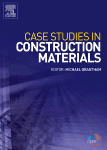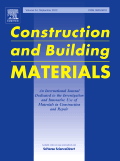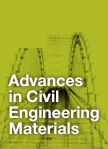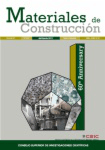
ADVANCES IN CEMENT RESEARCH
Scope & Guideline
Driving Progress in Building and Construction Research
Introduction
Aims and Scopes
- Sustainable Cement Production:
Research exploring the use of alternative materials and waste products in cement manufacturing, aiming to reduce environmental impact and enhance sustainability. - Innovative Cement Formulations:
Studies investigating new cement compositions, including the use of supplementary cementitious materials (SCMs) and novel additives to improve strength, durability, and other performance characteristics. - Durability and Performance Assessments:
Research focusing on the long-term performance of cement-based materials under various environmental conditions, including resistance to chemical attacks and mechanical stresses. - Advanced Characterization Techniques:
Utilization of sophisticated analytical methods to understand the microstructural and chemical properties of cement and concrete, aiding in the development of improved materials. - Application of Smart Technologies:
Exploration of the integration of smart materials and technologies in concrete, such as self-sensing and self-healing capabilities to enhance structural performance.
Trending and Emerging
- Geopolymer and Alkali-Activated Materials:
There is a growing interest in geopolymer and alkali-activated materials as sustainable alternatives to traditional cements, driven by the need for low-carbon construction solutions. - Nanotechnology in Cementitious Materials:
Research on the incorporation of nanomaterials, such as nano-silica and carbon nanotubes, is trending as it shows promise in enhancing the mechanical and durability properties of cement-based composites. - Waste Utilization in Cement Production:
Increasing focus on the utilization of industrial by-products and waste materials in cement production reflects a trend towards circular economy principles in construction. - Smart and Self-Healing Concrete:
Emerging research on smart concrete technologies, including self-healing and self-sensing properties, indicates a shift towards more resilient and intelligent construction materials. - Environmental Impact Assessments:
There is an increasing emphasis on life cycle assessments and environmental impact studies of cement-based materials, addressing the need for sustainability in construction practices.
Declining or Waning
- Traditional Portland Cement Studies:
Research focusing solely on traditional Portland cement formulations is becoming less frequent as the field shifts towards more innovative and sustainable alternatives. - Basic Chemical Additives:
Studies that primarily explore the effects of conventional chemical additives without consideration of their environmental impact or new formulations are declining. - Standard Testing Procedures:
While still important, there appears to be a reduced emphasis on conventional testing methods in favor of more advanced and integrated approaches to material performance assessment.
Similar Journals

Cement Wapno Beton
Exploring Sustainable Solutions in ConstructionCement Wapno Beton is a renowned academic journal published by STOWARZYSZENIE PRODUCENTOW CEMENTU, focusing on the intricate fields of building and construction, as well as materials science. With the ISSN number 1425-8129, this publication has been committed to advancing knowledge and fostering innovation since its inception in 2007, and it will continue until 2024. The journal operates within a competitive landscape, as reflected in its 2023 Scopus rankings, placing it in the third quartile (Q3) in both Building and Construction and Materials Science categories. Although it currently does not offer open access options, Cement Wapno Beton remains an essential resource for researchers, professionals, and students seeking valuable insights into the latest developments and technologies in construction materials. Its scope encompasses a wide range of topics, including architectural advancements, sustainable building practices, and innovative material applications, making it an indispensable tool for those dedicated to the evolution of construction science.

MATERIALS SCIENCE AND TECHNOLOGY
Pioneering Research in Materials Engineering and ApplicationsMATERIALS SCIENCE AND TECHNOLOGY is a leading journal published by SAGE PUBLICATIONS INC, focusing on the interdisciplinary advancements in the field of materials science. Since its inception in 1984, the journal has provided a platform for researchers and industry professionals to present innovative findings through rigorous peer-reviewed articles. The journal holds a commendable impact factor and categorizes itself within the prestigious Q2 rank in various domains such as Condensed Matter Physics, Materials Science, Mechanical Engineering, and Mechanics of Materials according to the 2023 Quartiles. With no Open Access option, it primarily serves as a repository for in-depth studies and advancements that push the boundaries of materials engineering and application. Located in the United Kingdom, at 2455 TELLER RD, THOUSAND OAKS, CA 91320, the journal continues to attract a global readership, making it indispensable for academics, researchers, and students who aim to stay at the forefront of materials innovation.

Case Studies in Construction Materials
Pioneering Research in Material Science ExcellenceCase Studies in Construction Materials, an esteemed journal published by Elsevier, provides a vital platform for the dissemination of scholarly research in the field of materials science, focusing particularly on innovations and advancements in construction materials. With its Q1 ranking in the 2023 Scopus category of Materials Science (Miscellaneous), the journal stands out for its high-impact contributions and commitment to enhancing industry practices. Open Access since 2014, Case Studies in Construction Materials promotes wide accessibility and engagement, encouraging collaborations among researchers, professionals, and students globally. Whether delving into innovative methodologies, sustainability in construction materials, or case studies that exemplify best practices, this journal is crucial for those seeking to advance the science and application of construction materials. Located in Amsterdam, Netherlands, its robust publication history from 2014 to 2024 ensures it remains a leading resource for contemporary research and academic exploration.

Construction and Building Materials
Transforming the future of construction through cutting-edge research.Construction and Building Materials, published by ELSEVIER SCI LTD, is a highly regarded journal in the fields of Construction and Building, Civil and Structural Engineering, and Materials Science. With an impressive Q1 ranking across multiple categories in 2023, the journal is recognized for its high-impact research, reflected in its Scopus rankings—13th out of 379 in Civil and Structural Engineering and 9th out of 223 in Building and Construction. Spanning from 1987 to 2024, it serves as a pivotal resource for researchers, professionals, and students aiming to explore advances in materials used in construction and their applications. However, it does not currently offer Open Access options. The journal stands as a vital platform for disseminating cutting-edge findings that can drive innovation and efficiency in the construction industry while addressing contemporary challenges, thus reinforcing its significance in shaping sustainable practices and technological advancements.

ACI MATERIALS JOURNAL
Leading the Charge in Materials Research and DevelopmentWelcome to the ACI Materials Journal, a premier publication in the field of materials science and engineering, published by the American Concrete Institute. Since its inception in 1987, this journal has continually contributed to advancing the understanding of concrete materials and structures, playing a vital role in both academic and practical applications. With an impressive impact factor and consistently ranking in the Q1 category for Building and Construction and Civil and Structural Engineering, the ACI Materials Journal is recognized for its rigorous peer-review process and high-quality research contributions. It serves as a crucial platform for researchers, practitioners, and students, featuring articles that explore innovative materials, sustainable practices, and cutting-edge technology, all of which are essential for the future of the civil engineering domain. Although the journal is not open access, it remains accessible to a vast audience through institutional subscriptions.

Advances in Civil Engineering Materials
Advancing Knowledge for Safer, Smarter InfrastructureAdvances in Civil Engineering Materials, published by the American Society for Testing and Materials, is a leading journal in the field of civil engineering, specializing in the innovative applications and developments of materials used in construction and infrastructure. With an ISSN of 2379-1357 and an impressive lineup of contributions from renowned researchers, this journal serves as a pivotal platform for disseminating groundbreaking research from 2012 to 2024, currently enjoying a category quartile ranking of Q2 across multiple disciplines including Ceramics and Composites, Civil and Structural Engineering, and Materials Chemistry. Though it operates under a subscription model, the valuable insights and advancements presented in the journal have a significant impact on both academia and industry practices. Researchers, professionals, and students are invited to explore the evolving landscape of civil engineering materials, gaining critical knowledge to drive innovations and contribute to the sustainability and safety of architectural endeavors.

Bauphysik
Innovating the Future of Architecture and ConstructionBauphysik, published by ERNST & SOHN, is a prestigious journal dedicated to the fields of architecture, building construction, and environmental engineering. With a strong focus on the principles of building physics, Bauphysik serves as a key platform for researchers, professionals, and students alike, disseminating vital information and advancements within the industry. The journal, boasting an ISSN of 0171-5445 and an E-ISSN of 1437-0980, is well-regarded with a categorization in the Q2 quartile in Architecture and Q4 quartiles in Building and Construction and Environmental Engineering as of 2023. Its Scopus ranks further highlight its impact within the community, with rankings of 83/189 in Architecture, 179/223 in Building and Construction, and 167/197 in Environmental Engineering. Despite its lack of open access options, the journal's retrospective convergence from 1982 to 2024 marks its long-standing influence in advancing building physics research. With a dedicated readership, Bauphysik encourages the exploration and sharing of innovative solutions to contemporary challenges in the built environment.

Proceedings of the Institution of Civil Engineers-Construction Materials
Transforming Civil Engineering Through Material ResearchProceedings of the Institution of Civil Engineers - Construction Materials is a leading journal dedicated to advancing the field of civil engineering, with a specific focus on construction materials. Published by Emerald Group Publishing Ltd in the United Kingdom, this journal serves as a critical platform for disseminating innovative research and practical applications in material science and structural engineering. With an ISSN of 1747-650X and E-ISSN 1747-6518, it spans an impressive timeline from 2006 to 2024, encapsulating pivotal studies that influence contemporary engineering practices. As a Q3 journal in the categories of Civil and Structural Engineering, Materials Science, and Mechanics of Materials, it reflects a solid academic standing, holding ranks of 152 out of 379 in Civil Engineering and 171 out of 398 in Mechanics of Materials, positioning itself within the esteemed scholarly community. The journal's objectives include promoting innovative material applications and fostering collaboration among professionals and researchers in the field. Although it does not currently offer open access, its comprehensive insights and findings are invaluable for researchers, professionals, and students striving for excellence in civil engineering and materials science.

MATERIALES DE CONSTRUCCION
Connecting Knowledge and Innovation in ConstructionMATERIALES DE CONSTRUCCION is a leading international journal dedicated to the fields of Building and Construction, Materials Science, and Mechanics of Materials, published by the CONSEJO SUPERIOR INVESTIGACIONES CIENTIFICAS-CSIC in Spain. With a rich history dating back to 1957 as an Open Access journal, it provides an invaluable platform for disseminating research findings that advance the science and application of materials in construction and engineering. The journal, indexed in Scopus, maintains a Q2 ranking in esteemed categories such as Building and Construction, and demonstrates significant impact with its ranking placements, including #91 in Building and Construction and #197 in Mechanics of Materials. Aimed at researchers, professionals, and students, MATERIALES DE CONSTRUCCION is committed to publishing high-quality studies that reflect the latest advancements in the discipline, fostering innovation and collaboration within the scientific community. For its readers, the journal offers a wealth of knowledge accessible from anywhere, ensuring that vital research is shared and utilized across the globe.

Epitoanyag-Journal of Silicate Based and Composite Materials
Exploring the Future of Composite MaterialsEpitoanyag-Journal of Silicate Based and Composite Materials is a premier international journal published by the Scientific Society Silicate Industry-SZTE, focusing on the development and application of silicate and composite materials. With its Open Access policy established in 2013, this journal provides a platform for researchers, professionals, and students to disseminate and access high-quality research without barriers. The journal aims to foster advancements in the field by covering a broad spectrum of topics, including material characterization, innovative applications, and sustainability initiatives related to silicate-based and composite materials. Its commitment to sharing valuable research makes it an essential resource for those looking to stay at the forefront of material science. Located in Budapest, Hungary, the journal not only serves a global audience but also contributes to the ongoing dialogue within the materials science community.